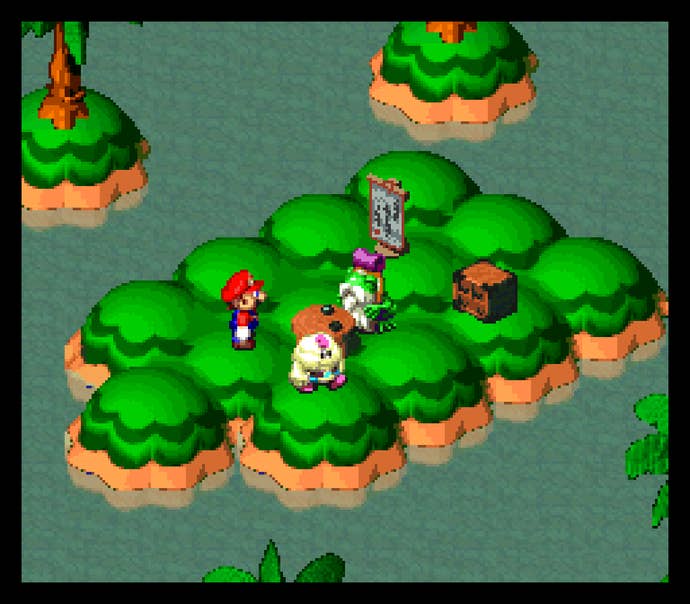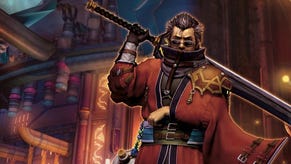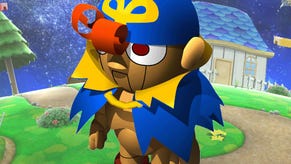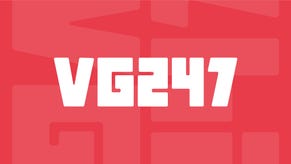Super NES Retro Review: Super Mario RPG: Legend of the Seven Stars
Join us as we review every Super NES Classic game. Next up: A strong relationship is forged -- and ends -- under the starlight.
This article first appeared on USgamer, a partner publication of VG247. Some content, such as this article, has been migrated to VG247 for posterity after USgamer's closure - but it has not been edited or further vetted by the VG247 team.
Join us as we review all the games on the SNES Classic Mini Edition in chronological order!
The other day, I wrote about how the mid-'90s break-up of Squaresoft and Nintendo disturbed me on a profound level. At the time, I clung to magazine snippets about "Final Fantasy VII for the N64 / Final Fantasy 64" (which turned out to be footage from a Silicon Graphics computer test) as supposed proof that Square and Nintendo were still hunky-dory with each other.
I fell back on another piece of "proof," too: Super Mario RPG: Legend of the Seven Stars for the SNES, a joint project between Super Mario's caretaker and the industry's number-one RPG tailor at the time. I figured the game wouldn't exist if Nintendo and Square weren't talking to each other.
All my hopes proved futile: The two companies ended their close relationship as the industry drifted from 16-bits to 32- and- 64-bits. Not only that, it'd be quite some time before we saw Squaresoft lend Nintendo consoles any kind of support, let alone Final Fantasy titles. Super Mario RPG was the last handshake between the industry giants – but at least it was a hell of a strong handshake.
Super Mario RPG isn't as deep as Final Fantasy VI. It isn't as fascinating as Chrono Trigger, or as heartfelt as EarthBound. But it's still an exceptionally important RPG for a couple of reasons.

First, it introduced the concept of "timed hits," a mechanic that's since branched into most modern RPGs. When Mario enters combat, he and his pals don't simply stand like dunces while enemies wail on them. By responding to visual cues and hitting the "A" button at the right moment, Mario and company can dampen the damage enemies inflict. Hitting "A" at key times during attacking or using magic spells also makes them more powerful. Since enemies telegraph their attacks differently, and since Mario's friends likewise have attacks that change up according to the weapon they wield, Super Mario RPG keeps you on your toes. You're rewarded for paying close attention, which does a lot to take the tedium out of the RPG genre's infamously slow, menu-based battles. Timed hits might be the most vital addition to RPG battle systems since Final Fantasy IV's Active Time Battle mechanic, and it pairs brilliantly well with Mario RPG's protagonist. After all, Mario is an action game star first and foremost.
Another reason why Super Mario RPG's contributions to the genre can't be over-stated: Like Final Fantasy VII, it introduced a not-small number of RPG-avoidant people to the genre. Mario's familiar mustached face was a big draw, but so was the aforementioned timed hits system. It gave players some control over fights, which in turn made the RPG aspects of the game less intimidating.

Therein lies one of Super Mario RPG's failings, though: It's a pretty easy journey, especially if you enter it as an RPG nut. Besides the timed hits, the game holds players' hands in other ways. You can choose to power-up a bonus stat every time a character levels up, powerful healing items are plentiful (and you're often rewarded with "Freebies!" when you use one), and the game's just not very long overall.
That doesn't mean RPG enthusiasts should take a pass on Super Mario RPG, though. Its sometimes-uproarious sense of humor means it's worth every second of your time (I kind of wish Mario still pantomimed to telegraph his feelings), to say nothing of its soundtrack, which is composed by the indescribably talented Yoko Shimomura. Chrono Trigger's To Faraway Times is my favorite game ending theme, but I'm damned if Happy Parade doesn't come close to usurping it. Shimomura masterfully remixes classic Mario tunes while supplying plenty of new material. You won't catch me complaining if Beware the Forest's Mushrooms makes it into a mainline Mario game somehow. And, hey, there's even a bonus remix of Final Fantasy IV's boss theme.

In fact, Super Mario RPG's blending of Mario mythos with Squaresoft's own ideas is seamless – for the most part. While the game doesn't usurp Nintendo's canon for its own ideas a la the Kingdom Hearts series, observant players can still detect parts of the game where Square tested its limits. For example, I believe Nintendo's current goofy, lovable rendition of Bowser owes a lot to Super Mario RPG, but I can't help but notice how toothless he is (outside of battle, of course, where he wreaks beautiful havoc with his teeth, spikes, and claws). Within an hour of gameplay, Bowser's plans to kidnap Peach go awry. Nothing new there, but then he's kicked out of his own castle, his troops abandon him, and he's supplanted by much more serious-seeming villains like Exor and Smithy. It feels like Squaresoft is wordlessly telling Nintendo "You write dumb stories. Stand back and watch what we can do."
Bowser's defanging isn't the only example of this behavior from Square. Most of the bosses you fight are of Square's own invention, and Geno just straight-up says he chose to inhabit the body of a "Geno" doll because it looked more powerful than the Mario, Peach, and Bowser dolls.
(Though Geno is kind of amazing, to be honest.)

Despite Super Mario RPG's occasional storytelling tug-of-war, it still takes you to fascinating locales that have the charm you'd expect from a game made jointly by Nintendo and Square. There are seething volcanoes, lofty cloud kingdoms, giant beanstalks, and sunken ships. Interestingly, though the game's rendered graphics were considered cutting-edge at the time, Super Mario RPG isn't as easy on the eyes as Chrono Trigger. But even when the game was brand-new, I wasn't a fan of how its isometric perspective forces about 25% of the screen to be covered in a plain blue field. It's not so bad if you tell yourself it's water – until Mario comes across an actual lake or pond and it spoils the illusion.
Still, the enemy models are imaginative and well-animated, and Square gave some clever attention to Nintendo's bestiary. The Czar Dragon is a nice re-purposing of a Blargg from Super Mario World – and its name is a reference to a boss that was cut from Final Fantasy VI. See, Square? That's how you honor source material while putting your own unique stamp on it!
Some fans of Super Mario RPG argue it's the best title in the now-lengthy Mario RPG series of games. I disagree. I believe it's lapped by Paper Mario: The Thousand Year Door for the GameCube, and Mario & Luigi: Bowser's Inside Story for the Nintendo DS. Nevertheless, Super Mario RPG was the start of something great, it's still something great, and I'd step over my own grandmother to have another Mario RPG collaboration between Square and Nintendo.
(As long as Nintendo reins in Square before it mummy-wraps Mario in leather and zippers, or whatever.)
ConclusionSuper Mario RPG doesn't have the epic story of Final Fantasy III or the visual charm of Chrono Trigger, but its unique battle system still helps make it one of the best RPGs on the SNES – and one of the most important RPGs ever made. It's not a long game, but it's a fun romp from end-to-end.








